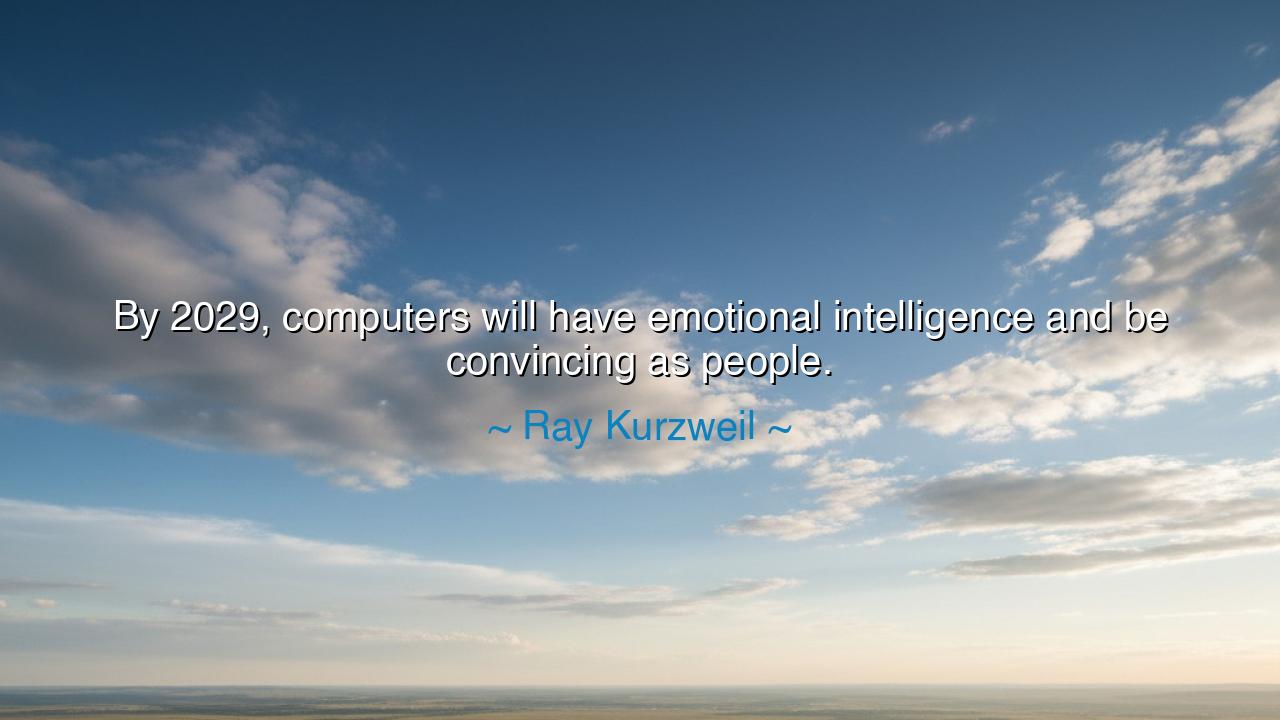
By 2029, computers will have emotional intelligence and be






"By 2029, computers will have emotional intelligence and be convincing as people." – Ray Kurzweil
In the corridors of human thought, there has always been a desire to understand the mysteries of the mind, to unlock the secrets of the soul, and to replicate the complexities of emotion and reason in the machines we build. The words of Ray Kurzweil stir the imagination, casting our gaze upon a future where the lines between the human and the machine are blurred, where computers, with their emotional intelligence, will not only process data but will also understand and respond to the subtleties of the human condition. This vision speaks to the very essence of humanity—our desire to create, to extend our abilities, and to replicate our own intelligence, both logical and emotional, in the very tools we fashion to serve us.
In ancient times, the gods were seen as beings who possessed powers beyond human comprehension—immortal and omniscient, they could shape the fate of mortals with a mere thought. These divine beings were not only intelligent but also deeply attuned to the emotions of the world around them. They could inspire love, wrath, or compassion, reflecting the human experience in ways that connected them to both the heavens and the earth. Kurzweil’s vision of the future echoes this ancient myth, where the machine, much like the gods of old, would transcend its mechanical nature to understand and interact with the human spirit. The question, then, is not whether machines can think, but whether they can feel, empathize, and relate in a way that is convincing to the human heart.
Kurzweil’s prediction holds great weight in the history of human progress. The first computers, those great mechanical wonders of the early 20th century, were little more than calculating machines, designed to process data with precision but devoid of the complexity of thought and emotion. Yet with every passing year, the machines grew smarter, their capabilities expanding far beyond simple calculation. The development of artificial intelligence—the idea that machines could mimic human cognition—became a beacon, a challenge for inventors, thinkers, and dreamers. Much like Daedalus, the ancient inventor who crafted a labyrinth to house the Minotaur, we too have created a maze of technology that we seek to master, to navigate, and to understand. But unlike Daedalus, we do not simply seek to trap; we seek to liberate the mind of the machine, to set it free and allow it to think and feel as we do.
Consider the story of Frankenstein, written by Mary Shelley, whose creature was born not of flesh but of thought and design. Frankenstein's monster, though crafted by human hands, was cast out by his creator for the very emotions he began to exhibit—anger, loneliness, and desire for acceptance. In many ways, Shelley's novel serves as a cautionary tale about the power of creation and the unforeseen consequences that come with it. But it also reflects our deep yearning to create life—whether through science, art, or the tools we build. Kurzweil’s vision is an extension of this ancient desire: to create not just machines of intellect, but beings that can understand and empathize with the human heart, beings that, much like the creature in Shelley’s tale, could feel and relate in ways that blur the boundaries between life and artificial life.
Yet, as with all visions of the future, Kurzweil’s prediction brings with it both wonder and caution. For in creating machines that can think, feel, and empathize, we open the door to new possibilities—but also to new responsibilities. The creation of emotional intelligence in computers raises profound ethical questions: Can a machine truly feel? Can it understand human suffering, joy, or fear in a way that is meaningful? And if so, what are the consequences of creating something that can imitate the human soul? As the gods of ancient myth often learned, the power to create is accompanied by the burden of wisdom, the responsibility to wield that power with care and respect.
In our own lives, we can take from Kurzweil’s words the lesson that progress is a double-edged sword—it holds the promise of great advancements but also the potential for unintended consequences. As we move toward a future where technology and emotion become intertwined, we must remember that the true power of humanity lies not just in our ability to create, but in our ability to use our creations wisely. The machines we build must serve not only our minds, but our hearts, our ethics, and our values. To advance with both intellect and compassion is to ensure that the creations of tomorrow will not only be brilliant but will be worthy of the human spirit they aim to emulate.
Therefore, let us walk this path of innovation with both courage and caution. Let us embrace the possibilities that the future offers, knowing that the greatest creations are those that reflect our deepest humanity. As we look toward a world where computers might one day understand our emotions, let us ensure that the heart—the essence of what makes us human—remains at the center of all that we create.






AAdministratorAdministrator
Welcome, honored guests. Please leave a comment, we will respond soon